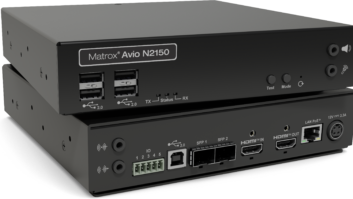It can be interesting to chart the development of editorial coverage about AV networks, and in particular the way in which the overwhelming ‘why’ or ‘if’ of 10 years ago has been gradually supplanted by ‘how’ and ‘when’. The desirability of implementing comprehensive networks in any manner of professional install environments – from conference centres to concert halls – has been established to the point where the discussion has invariably shifted towards topics such as (re)configuration, future expansion and network maintenance.
But it is arguable that we are now heading into another period of change as AV and IT networks are more frequently converged, and as talk of 1Gb networks begins to be replaced by anticipation of 10Gb or even 40Gb networks in order to offer the necessary bandwidth and ‘futureproofing’. The advantages of placing AV on IT networks can be significant in terms of cost and streamlining network operations, but video brings with it its own (potentially substantial) demands with regard to compression and latency. These are such that, in many cases, the recommendation is still often to keep AV and IT networks separate.
Basic considerations
In terms of planning a network, the first question we should be asking is “what is the most appropriate method of deployment for this client and project – install a dedicated AV network or utilise the customer’s corporate network,” says QSC product manager for installed systems, Martin Barbour. “From an end-user perspective, they are investing millions of dollars in a site-wide network infrastructure that is modern, robust and designed to keep all their IT assets moving forward. Therefore, it can be frustrating when AV specialists recommend or advise the installation of a dedicated AV network, merely to simplify the install process. This has to be weighed against the potential challenges involved with implementing network configurations required to accommodate real-time AV-over-IP on a multi-purpose corporate network.”
Discussions with IT professionals and AV specialists can usually be more productive if the proposed AV solution is based on common IT networking standards and solutions such as PTP, RTP, UDP and/or TCP/IP, for example. It is also important for the AV specialist to articulate how the solution will interact with other data on a common IT network, and what special considerations or configuration may be required to accommodate that solution on the network.
For Durai Ramachandiran – who is senior director, product line management for pro voice and audio video distribution at ClearOne – “it is always preferable to have both transport and control in the same network, and preferably in the existing network itself to reduce the installation and maintenance cost. Because of the matured TCP/IP protocols and the availability of advanced codec technologies, we can have both transport and control in the same network.”
At least one contributor to this article expressed regret that protocol selection is still such a recurrent topic, wishing instead that we had reached a point where protocols were effectively ‘transparent’ and we could move more firmly onto discussing the benefits of individual network solutions. But we are where we are, and it could be argued that the still considerable number of AV protocols hardly helps matters.
Ramachandiran offers a very succinct summary of the issues that continue to inform protocol selection: “The choice of protocol depends on various factors like bandwidth usage by each AV stream, the total number of AV streams required in a given installation, available network bandwidth, video quality, end-to-end latency, and interoperability with other devices.”
Zach Snook, product manager at Biamp Systems, say that “what needs to be achieved” by the network is invariably integral to the question of which protocol should be selected. “If interoperability is key then certain platforms have more interoperability, and then there are some platforms that have more support [in terms of related products on the market],” says Snook. Ultimately, it comes down to “what are the components [on the network] and which protocol best makes it happen.”
Like many vendors at the present time, Biamp has positioned itself on neutral ground – or as Snook puts it, “we live in the middle in that we try to be as supportive of as many protocols as possible,” thereby giving the customer the greatest leeway to implement the network solution of their choice.
Barbour (QSC) is aware that there is “no silver bullet that solves all problems for all users” and that each networked AV solution “has its own place. Different solutions may suit different markets and applications, and like many things in life there are often multiple suitable options for the task at hand.” Therefore, technology that supports as many options as possible is preferred.







